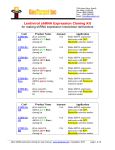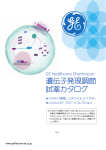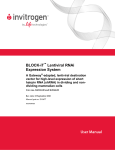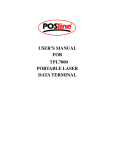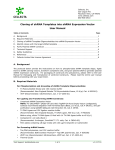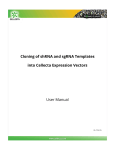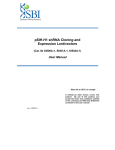Download shRNA expression Cloning Kit
Transcript
shRNA expression Cloning Kit User Manual for making lentiviral and non-lentiviral shRNA expression clones Cat# Product Name Amount Application Make shRNA expression lentivector with GFP-Blasticidin selection marker Make shRNA expression lentivector with GFP-Puromycin selection marker Make shRNA expression lentivector with RFP-Blasticidin selection marker Make shRNA expression lentivector with RFP-Puromycin selection marker Make non-lentiviral version of shRNA expression vector with GFP-Bsd selection marker LTSH-GB pEco-Lenti-H1-shRNA(GFP-Bsd) cloning kit 1 kit LTSH-GP pEco-Lenti-H1-shRNA(GFP-Puro) cloning kit 1 kit LTSH-RB pEco-Lenti-H1-shRNA(RFP-Bsd) cloning kit 1 kit LTSH-RP pEco-Lenti-H1-shRNA(RFP-puro) cloning kit 1 kit SH-GB pEco-H1-shRNA-(GFPBsd) cloning kit 1 kit Each Kit Contents Amount One of the following pre-cut, linear vector (dependent upon the Catalog #): pEco-Lenti-H1-(GFP-Bsd) linear vector; or: pEco-Lenti-H1-(GFP-Puro) linear vector; or: pEco-Lenti-H1-(RFP-Bsd) linear vector; or: pEco-Lenti-H1-(RFP-Puro) linear vector; or: pEco-H1-shRNA-(GFP-Bsd) 10x shRNA oligo annealing solution 20ul (for 20 rxn) 50ul 5X ligation buffer 50ul T4 ligase enzyme 20ul (20rxn) Cloning control insert: annealed Luc-shRNA duplex [1x]: 20ul (20rxn) 5’- AGCGatgaaacgatatgggctgaatacCGAGgtattcagcccatatcgtttca tactttgctatacccgacttatgGCTCcataagtcgggtatagcaaagtAAAA Sequencing primer: 5’- ggatccaatatttgcatgtcgctatg DH5a chemical competent cells 1 tube (20ul x 25ng/ul ) (20 rxn) 50ul x 20 vials (20rxn) pEco shRNA cloning kit- user manual Page 1 of 12 Storage: shRNA Cloning Kit is shipped on dry ice. Each kit contains sufficient amounts for 20 shRNA cloning reactions. Upon received, stored at -80oC. Products stable for 6 months. Quick protocol outlines (for experienced users): 1. Design two DNA oligonucleotides encoding shRNA sequence, 2. Anneal the two oligo to generate a duplex; 3. Clone the duplex into provided linear pEco-shRNA vector by T4 ligation reaction; 4. Transform into competent cells and grow in LB/ ampicillin plate; 5. Confirm positive clone by sequencing; 6. Knockdown analysis after transfection of shRNA plasmids into mammalian cells; 7. Produce shRNA lentivirus (for lentivectors only) and transduced into desired cells for knockdown analysis or generate shRNA stable cells. Cloning Scheme Overhang Sense(19-21) loop Antisense (19-21) AGCG NNNN…NNNNCGAGNNNN…NNNN NNNN...NNNNGCTC NNNN…NNNNAAAA H1 Promoter TTTTTT TCGC pEco shRNA cloning kit- user manual Page 2 of 12 H1 promoter GGATCCAATA TTTGCATGTC GCTATGTGTT CTGGGAAATC ACCATAAACG CCTAGGTTAT AAACGTACAG CGATACACAA GACCCTTTAG TGGTATTTGC 1 TRBS ~~~~~~~~~~~~~~~~~~~~~~~ 51 TRBS ~~~~~~~~~~~~~~~~~~~ TGAAATCCCT ATCAGTGATA GAGACTTATA AGTTCCCTAT CAGTGATAGA ACTTTAGGGA TAGTCACTAT CTCTGAATAT TCAAGGGATA GTCACTATCT Transcription start ~~ 101 GA CTTCGC TTTTTTGGCCGGCC ACCGGTTAGT AATGATCGAC AATCAACCTC AACCGGCCGG TGGCCAATCA TTACTAGCTG TTAGTTGGAG TRBS: Tetracycline Repressor Binding Site. Vector Schematic maps Inducible shRNA lentivector scheme (Cat#: LTSH-GB, LTSH-GP, LTSH-RP, LTSH-RP) Inducible H1 Rsv 3’LTR (SIN) cppt RRE 5LTR Ψ RFP-Bsd / RFP-Puro / GFP-Bsd / WPRE GFP-Puro shRNA vector scheme (Cat#: sh-GB) (non lentiviral version) Inducible H1 Rsv GFP-Bsd Note: The vector’s full sequence can be requested to [email protected]. To make the final clone’s map, simply paste shRNA hairpin insert sequence (not include both 4bp overhangs) between position 106 and 107. pEco shRNA cloning kit- user manual Page 3 of 12 Introduction: RNA interference (RNAi) technology is a tool for lost-of-function (knockdown/silencing) studies in mammalian cells without making knock-out germline cells. Originally, double-strand short RNAs were found in vivo inhibiting gene expression. The mechanism is a serie of enzymatic reactions mediated by short RNAs that are complementary in sequence to the silenced targets, leading to mRNA degradation or translational repression. RNAi knockdown can be introduced by synthetic short double-strand RNA (siRNA) or vector expressed stemhairpin RNA (shRNA) which was further processed by Dicer enzyme to producing doublestrand short RNAs. Another category of RNAi found in vivo is micro-RNA (miRNA) which has similar knockdown mechanism. Native or artificial miRNA can be processed from premicro RNA expressed via some vectors. Chemical synthesized double stranded RNA (siRNA) is only for transient silencing effect. In contrast, vector expressed RNAi can provide a long term effect by stable selection. Vector expressed RNAi for gene silencing provides an alternative, convenient method to functional studies in both animal and cell line models. Variety RNAi vectors are commercially available now in the market. Lentivectors are HIV-1 (Human Immunodeficiency Virus 1) derived plasmids, used to generate lentiviral particles (lentivirus) that can be transduced into virtually all kinds of mammalian cell types or organs, including stem cells, primary cells and non-dividing cells both in vivo and in cell culture system. Particles stably integrate into the transduced cells’ genome for long term expression. shRNA expression vectors with different markers: AMSBIO provides cloning kits for making shRNA expression clones with different selection markers in both lentivectors (Cat#: LTSH-GB, LTSH-GP, LTSH-RB, LTSH-RP) and regular non-lentiviral vector (Cat#: SH-GB). Each kit contains a pre-cut, ready-to-use linear vector for ligation of shRNA duplex sequence. The linear vector was designed for cloning of double-strand DNA encoding a short hairpin RNA. Once transcribed, the shRNA would be processed into short RNA in vivo for RNAi analysis. To make shRNA expressing vector, two synthetic oligonucleotides would first to be annealed to form the DNA duplex which would be then cloned into the linear vector via T4 enzyme ligation. The transcription of shRNA is driven by tetracycline optional inducible human H1 promoter, a RNA polymerase III promoter. The vector can be used for constitutive high level expression of shRNA without any induction. However, optionally, it can be used as tetracycline inducible expression. For inducible expression, the shRNA expression can be repressed in the presence of TetR and induced by tetracycline. The expression of TetR can be achieved by using the Tet-repressor stable cell line (Cat# SC005) or using our pre-made Tet-repressor lentiviral particles, or by cotransfection with the TetR expression vectors. pEco shRNA cloning kit- user manual Page 4 of 12 This lentiviral version of shRNA vector allows the generation of shRNA lentiviral particles that can be transduced into your desired cell lines. The shRNA stable expressing cells can then be selected by the Blasticidin or Puromycin depending on the product chosen. Each Kit provides enough materials for 20 cloning reactions, for generation of your own lentiviral shRNA expressing clones with the following advanced features. Key Features: 1. Linearised vector and ready for use, no need for the tedious bench works for preparation of vector backbone; 2. Precisely directional cloning of your DNA duplex encoded shRNA structure; 3. Rapid, high efficient cloning with low background (Room temperature for 30min, >90% positive rate); 4. Internal transfection efficiency reference: the vector encode a fluorescent protein (GFP or RFP), allowing real-time monitoring and normalizing the transfection differences; 5. Long-term stable silencing effect: the vector encode a dual marker (a fluorescent maker fusion with an antibiotic resistance marker) allowing to generate stable cell lines for long-term knockdown; 6. Generated lentiviral shRNA particles can be transduced into your cells of interested (Note: lentivector can be transfected into cells for gene expression knockdown. It can produce lentivirus to transducer the hard-transfected cells for long term knockdown study.) 7. Optional inducible knockdown: This lentivector (or its lentivirus) can be used as constitutive high expression of shRNA without needs for any induction. However, two Tet-repressor binding-sites (TRBS) have been integrated in the human H1 promoter, allowing inducible expression of shRNA when the tetracycline repressor protein (TetR) exists in advance (see http://www.amsbio.com/Lentivirus.aspx for further information). Insert compatible: the same annealed shRNA duplex can be readily cloned into all other linear shRNA vectors with different selection markers (Cat#: LTSH-GB, LTSH-GP, LTSH-RB, LTSH-RP and SH-GB). Protocols: 1. Design single-stranded DNA oligonucleotides: Design two DNA oligonucleotides, a top strand and a bottom strand according to the following structure. The top strand has AGCG overhung at its 5’-end, followed by the selected target sequence (sense sequence) at 19 ~21 nucleotides, a CGAG loop (or use your own loop), and the reverse-complementary to the target sequence (antisense). The bottom strand has AAAA-overhung at its 5’-end and the rest are complementary to the top strand. pEco shRNA cloning kit- user manual Page 5 of 12 Overhang Sense (19-21nt) loop Antisense (19-21nt) 5’ AGCG NNNN…NNNNCGAGNNNN…NNNN NNNN...NNNNGCTCNNNN…NNNNAAAA 5’ Overhang Loop length has little or no effects on knockdown. Four nucleotides (CGAG) here are the tested good, minimal length for effective RNAi knockdown. You may design your own loop sequence such as a restriction enzyme (RE) recognition sequence. However, most RE sequences are palindrome structures which form a continuous hairpin structure with your RNAi sequence, which may not be processed correctly into RNAi by Dice in vivo. Two overhangs ensure the directional cloning of the annealed double stranded oligos into provided linear vector. The transcription start site is at the first nucleotide of the target sequence (sense) on the top strand. Native H1 RNA initiates at an A, so A was recommended to as the first base in sense target sequence. shRNA target sequence (sense) selection: There are some general guidelines for selecting the effective shRNA sequence. Many online tools or designers can help your selecting your shRNA sequence. Please see the following links. But effective RNAi target sequence has to be empirically verified. To avoid the off-target effect, design a scrambled sequence (from selected shRNA sequence) or an universal Null sequence as a negative control for knockdown analysis. 1. 2. 3. 4. 5. 6. Promega’s siRNA Target Designer; Clontech’s RNAi Target Sequence Selector; Gene Link shRNA designer; Invitrogen’s BLOCK-iT™ RNAi Designer; katahdin RNAi Central; WI siRNA selection program; pEco shRNA cloning kit- user manual Page 6 of 12 2. Cloning of shRNA expression plasmids: Anneal the designed two single-stranded DNA oligonucleotides: Set up the annealing reaction as follows: 100 µM Top strand oligo: 10 µl 100 µM Top strand oligo: 10 µl 10× oligo annealing buffer: 3 µl DNase-free water: 7 µl ---------------Total volume: 30 ul ------Incubate reaction mixture at 95°C for 5 minutes (can be done in PCR machine). Remove the tube and leave it on bench at room temperature to cool down for 10 ~ 30 minutes. Put tube on ice. Make 1: 1000 dilution (add 1ul annealed mixture in 99µl Cold-DNase free water, and then take 2ul, added into 18ul of 1x annealing solution on ice). Final diluted annealed duplex is ready for ligation. Save undiluted duplex at -20oC for long term storage. (Note: always put diluted, annealed duplex on ice to avoid double strand DNA melt.) Ligation reaction : Set up the ligation reaction as follows: pEco-Lenti-H1-shRNA linear vector: Annealed duplex (1: 1000 dilution): 5X T4-ligase buffer: DNase free water: T4 ligase: ----------------------------------------Total volume: 1 ul 1 ul 2 ul 4 ul 1 ul 10 ul ------- Mix reaction well and incubate for 30 minutes at room temperature (Note: Longer incubation would generate more colonies). Place reaction on ice. Set up a cloning positive control reaction by using 2ul of annealed Luc-shRNA duplex (provided, and thaw on ice). The positive clone generated from control Luc-shRNA duplex is capable of silencing firefly luciferase gene (see “Example of knockdown” below in this manual). Transformation: 1. Transfer 2ul of the ligation reaction into a vial of DH5a chemical competent E. Coli cells, gently mix. (Note: competent cell is available separately from AMSBIO, Cat#: CC01). 2. Place cells on ice for 5 minutes, then transfer cells into 42oC water bath, incubate for 30 seconds without shaking. Immediately transfer cells to ice. 3. Add 250ul of SOC medium; incubate at 37oC for 1 hour with shaking. pEco shRNA cloning kit- user manual Page 7 of 12 4. Spread 100ul of cultured cells on a pre-warmed LB plate containing 100ug/ml ampicillin, and incubate overnight at 37oC (Note: In general, you get 50~100 colonies from your reactions and 0 to 5 colonies from the no-insert control reaction.) 3. Confirm the positive clones: Pick 1~3 colonies, grow in LB/ampicillin medium, miniprep plasmid DNAs, send for sequencing using the provided sequencing primer. (Note: Primer provided are ready to use, concentrated at 25ng/ul, simply use 1ul per reaction. Sequencing of stem hairpin structure may need special solution for best result). Purified positive plasmid DNAs are ready for transfection into cells for knockdown analysis, or they can be used to produce lentiviral particles in packaging cell lines, and then the generated lentiviral particles can be used to transduce the cell line of your interest. 4. Produce shRNA lentiviral particles (for lentivector only): Note: Our pEco-Lenti-shRNA vectors are fully compatible with most current lentiviral system on market. So you can use your other vendor’s lentivirus production system for virus production, such as ViraPower / Block-it (Invitrogen), MissionShRNA(Sigma), LentX(Clontech), GIPZ Lentiviral ShRNAmir (Open Biosystem), etc. But the following protocol is recommended for the highest virus titers using AMSBIO’s lentiviral reagents. Cells: grow packaging cells, 293T-LV (cat# TLV-C) in 24-well plate 2.5 x 105 cell/well), incubated in 5% CO2 overnight. Transfection: at the time for transfection, cells should grow to 90% confluent. Add 100ul of serum-free medium (or Opti-Mem, Invitrogen) into 1.5ml tube, and then add 600ng of our packaging mix (Cat# HT-pack) and 300ng of shRNA lentivector. Use your desired transfection protocols according to the transfection reagent manual. Transfer all transfection mixture (~100ul) into a cell well in 24-well plate, incubated in 5% CO2 overnight. The next day, remove the medium and replaced with complete culture medium. Harvest virus supernatants at 48-72 hours after transfection. Centrifuge virus particles at 3000rpm x 15min at 4oC to pellet cell debris. Filter through a sterile 0.45um filter. Store virus at -80oC. pEco shRNA cloning kit- user manual Page 8 of 12 5. Transduction by the shRNA lentivirus and selection of the stable clones: Cells: plate the desired hosting cells at 10%-20% confluent, culture at 37oC overnight; Note: for inducible shRNA expression, a Tet-repressor stable cell line has to be used as hosting cells here to repress the expression in advance and expression can be induced later on by addition of tetracycline. AMSBIO provide a Tet-repressor expression cell lines with different antibiotics selection (Cat# SC005). On the 2nd day, thaw lentiviral stock, change medium with completed medium containing 6ug/ml polybrene; and add appropriate amounts of lentiviral particles into culture to get a range of MOI from 1 to 10 as desired, incubate at 37oC overnight; At 24 hours after transduction, remove the medium containing virus and replace with completed medium, 37oC overnight; At 72 hours after transduction, remove the medium and replaced with completed medium containing the appropriate amount of antibiotics to select for stably transduced cells. (Note: the amount of antibiotic added is dependent upon the cell types. A kill cure has to be tested for using the right amount of antibiotics. In general, use 0.5 ~ 10ug/ml of Blasticidin and 10-100ug/ml of Puromycin). Change medium containing Puromycin every 3-4 days; At the time when the mock well has no live cells, trypsinized the antibiotic-resistant colonies and make a series of dilution, seed into each well in 24-well plate, continue to grow cells, Inspect the cells under fluorescent microscope, select the wells that show GFP signal from all cells, grow cells up in large flash; Collect cells, and freeze down cells in cryogenic vial, saved as stable shRNA expression cell lines; Validation of shRNA knockdown: In general, most RNAi designers can obtain greater than 50% successfully rate with greater than 75% knockdown levels. However, there is no “holy-grail” for an ultimate RNAi designer. Effective RNAi sequence has to be empirically validated. To validate effective shRNAs, different approaches are used to measure the mRNA levels or its protein products, such as using Q-PCR or western blot. Alternatively, a reporter assay can be applied to screen shRNAs. One main concern for RNAi knockdown is the so called “Off target effect”. We designed a Null shRNA sequence as the universal negative control. It was designed against entire human and mouse transcripts with the minimal sequence humongous to any human or mouse ORFs pEco shRNA cloning kit- user manual Page 9 of 12 sequences to minimize the non-specific knockdown. This Null-control lentivector and its lentiviral particles are provided as catalog products. Please see validation example results below. The following results were validated with nonlentiviral version vector which has the identical shRNA expression core structure to all pEcoshRNA vectors. For you reference, please review the following expression knockdown results using our shRNA vector: Examples for knockdown using pEco-H1-shRNA-(GFP-Bsd) vectors: Example A: Luc-shRNA: (measure the luciferase activity by luciferase assay kit) Luc-shRNA top strand: 5’- AGCGatgaaacgatatgggctgaatacCGAGgtattcagcccatatcgtttca Luciferase activity 140000 120000 Knockdown of co-transfected luciferase by Luc-shRNA 107.54% 100% 100000 80000 60000 40000 26.67% 20000 0 Untransfected Luc-shRNA (700ng) Neg Ctr Knockdown of co-transfected luciferase expression in 293-HEK cells by pEco-H1-lucshRNA-(GFP-Bsd) plasmid. Luc-shRNA duplex was cloned into pEco-H1-shRNA-(GFP-Bsd) vector, then co-transfected pcDNA3.1-luciferase (firefly) plasmid (100ng) with Luc-shRNA plasmid (700ng) into 293HEK cells in 24-well plate. Cells were harvested at 3 days after transfection. Luciferase activity was measured from cell lysate (10ul/ea) using our luciferase reporter assay kit on LMax microplate luminometer. Null-shRNA plasmid serves as the Neg-Ctr plasmid here. pEco shRNA cloning kit- user manual Page 10 of 12 Example B: P53-shRNA: (Measure the mRNA level by real-time qPCR) P53-shRNA top strand: 5’- AGCGccactacaactacatgtgtaaCGAGttacacatgtagttgtagtgg p53/GAPDH P53-shRNA knockdown of hP53 in A549 cells (normalized to GAPDH) Neg Ctr 1.4 1.2 1.0 0.8 0.6 0.4 0.2 0.0 P53shRNA P53-shRNA Neg Ctr Knockdown of endogenous human P53 in A549 cells by pEco-H1-p53-shRNA-(GFP-Bsd) plasmid. P53-shRNA duplex was cloned into pEco-H1-shRNA-(GFP-Bsd) vector, and transfected into A549 cells, grown in medium containing 10ug/ml Blasticidin. Cells were harvested at 3 days after transfection. P53 levels were detected from extracted total RNAs by real-time Q-PCR assay. Data were normalized to internal level of GAPDH. Null-shRNA plasmid serves as Neg-Ctr. Conclusion: RNAi gene silence can be effectively carried out via pEco-H1-shRNA-(GFP-Bsd) vectors. Trouble shooting: Problems Solution Few or no colonies 1. Extend ligation time, or leave it at 4oC overnight; 2. Use more duplex: add 5ul diluted duplex in ligation reaction; 3. Or make freshly annealed duplex and diluted for ligation reaction; 4. Use different competent cells (your own); Related Products: Cat# HT-Pack TLV-C Product Name Lentiviral packaging plasmids 293TLV lentiviral packaging cells Amount Application 600ng/ul x Packaging for lentivirus 100ul production One vial lentivirus production cells ( > 2 x 106 cells) pEco shRNA cloning kit- user manual Page 11 of 12 Lentiviral shRNA cloning service: AMSBIO provides cost effective shRNA cloning services. Simply tell us the target you want to knockdown, we will design the shRNA for your target (or you provide the RNAi target sequence), and we clone shRNA sequences into our shRNA expression vectors with the selected marker. Sequencing verified shRNA plasmids and packaged lentiviral shRNA particles will be delivered to you. Our service has the fast turnaround time and lowest costs. Please have a look at http://www.amsbio.com/custom-lentivirus-service-inducible-shRNA-lentivirus.aspx . References: 1. 2. 3. 4. 5. Lee, R. C., et al, The C-elegans Heterochronic Gene lin-4 Encodes small RNAs with antisense complementarily to lin-14. Cell, 75(843-854), 1993. Hannon, G.J., RNA interference. Nature, 418(6894): p. 244-51, 2002. Bosher, M., et al, RNA interference, Nature Cell Biol. 2 E31-E36, 2000. Meister, G. and T. Tuschl, Mechanisms of gene silencing by double-stranded RNA. Nature, 2004. 431(7006): p. 343-9. Paddison, P.J., A.A. Caudy, and G.J. Hannon, Stable suppression of gene expression by RNAi in mammalian cells. Proc Natl Acad Sci U S A, 2002. 99(3): p. 1443-8. pEco shRNA cloning kit- user manual Page 12 of 12













